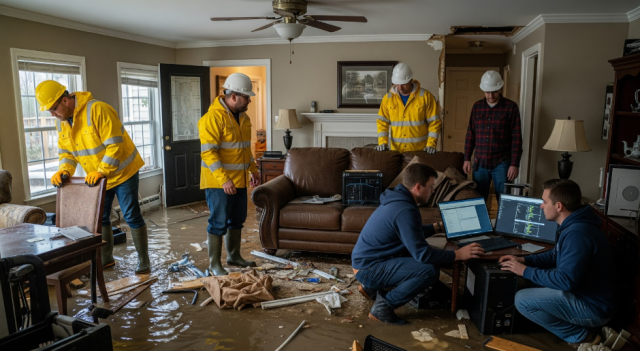An estimate that misses the mark, a schedule that doesn't align with crews and subs, or materials that aren't ordered in time can turn a profitable project into a costly one. Small gaps at the planning stage snowball into change orders, client frustration, and lost trust.
Preconstruction software gives restoration teams a way to get ahead of these problems by tightening estimates, streamlining schedules, and managing resources upfront.
In this article, we'll list the key ways preconstruction software helps restoration companies win more bids, avoid costly mistakes, and set themselves up for sustainable growth.
7 Ways Preconstruction Software Drives Restoration Business Growth
1. Centralized planning and collaboration
Successful restoration projects depend on how well teams coordinate before work begins. Preconstruction software creates a shared hub where estimators, project managers, subcontractors, and field crews can access the same data in real time. Estimates, schedules, material lists, and documentation are linked together instead of sitting in separate tools.
When you centralize planning and communication, decisions are made faster, handoffs are better, and details don't get missed. That upfront alignment reduces costly delays once work begins and builds trust with clients who see the project running on schedule.
2. Automated, accurate cost estimates
Every restoration job carries uncertainty like hidden water damage, mold growth, or structural issues that aren't obvious at first inspection. If estimates don't factor in labor, materials, equipment, permits, and overhead with enough accuracy, profit margins erode before work even begins. Optimized preconstruction software reduces that risk by pulling from real cost databases, past project data, and automated takeoffs to deliver detailed, consistent estimates.
The value goes beyond speed. Automated estimates help restoration companies:
- Bid competitively without undercutting profitability
- Spot where labor or material costs could push a project over budget
- Build in contingency allowances for surprises without scaring off clients
- Share transparent, data-backed proposals that strengthen trust with adjusters and property owners
3. Digital takeoffs for precise material quantification
Ordering too little slows a project down, while ordering too much ties up cash in unused inventory. Digital takeoff tools built into preconstruction software solve this by letting estimators measure directly from plans and drawings. Areas, lengths, and volumes can be calculated with a few clicks, eliminating the need for manual counting or guesswork.
There are benefits here: projects start with the right materials on site, and budgets reflect the true scope of work. This precision reduces waste, prevents costly reorders, and helps restoration companies deliver estimates that are both competitive and realistic.
4. Streamlined scheduling and resource allocation
Delays can escalate costs quickly, leaving crews waiting or jobs overlapping. Preconstruction software helps avoid these pitfalls by connecting schedules with labor, equipment, and material availability before work begins.
Project managers can see which crews are available, what equipment is in use, and how long each task is expected to take. If one phase runs long, schedules can be adjusted in real time with visibility into the ripple effects on other tasks. This makes it easier to prevent overbooking, reduce downtime, and keep projects moving smoothly.
5. Real-time updates and historical data insights
To grow your restoration business, you need both clarity in the moment and lessons from the past. Preconstruction software delivers on both fronts. Real-time updates keep estimators, project managers, and crews aligned as changes happen—whether it's a revised estimate, a scheduling shift, or an updated material order.
At the same time, the software captures historical data from completed jobs. Over time, this creates a reliable record of what drove costs up, which suppliers consistently delivered on time, and where projects tended to stall. With that knowledge, restoration companies can refine their bids, allocate resources more effectively, and avoid repeating costly mistakes.
6. Efficient document and bidding management
Restoration projects involve a constant flow of paperwork, plans, permits, contracts, compliance forms, insurance documents, and client communications. When these live in separate folders or email chains, it's easy for versions to get mixed up or critical approvals to be delayed. Preconstruction software centralizes this information so teams always work from the most up-to-date documents.
The same platform also simplifies the bidding process. Instead of manually sending out bid packages, tracking responses, and reconciling numbers, project managers can manage everything digitally. Subcontractors receive the right information, bids are logged automatically, and proposals can be compared side by side.
7. Business visibility with analytics and reporting
Restoration companies can only improve what they can measure. Preconstruction software provides dashboards and reports that bring together data on labor hours, material usage, equipment costs, and project timelines. Instead of piecing together insights from scattered spreadsheets, leaders get a clear view of performance across all active and completed jobs.
Analytics make it easier to spot which project types deliver the highest margins, where delays most often occur, and how closely actual costs align with estimates. This visibility supports smarter bidding strategies, more accurate forecasting, and stronger client communication.
Turning Planning Into Growth
Restoration companies lose money when projects start with shaky estimates, scattered schedules, and unclear communication. Preconstruction software addresses those problems before the first crew steps on site. The payoff is competitive bids, quicker delivery, and the ability to take on growth without stretching resources thin.






